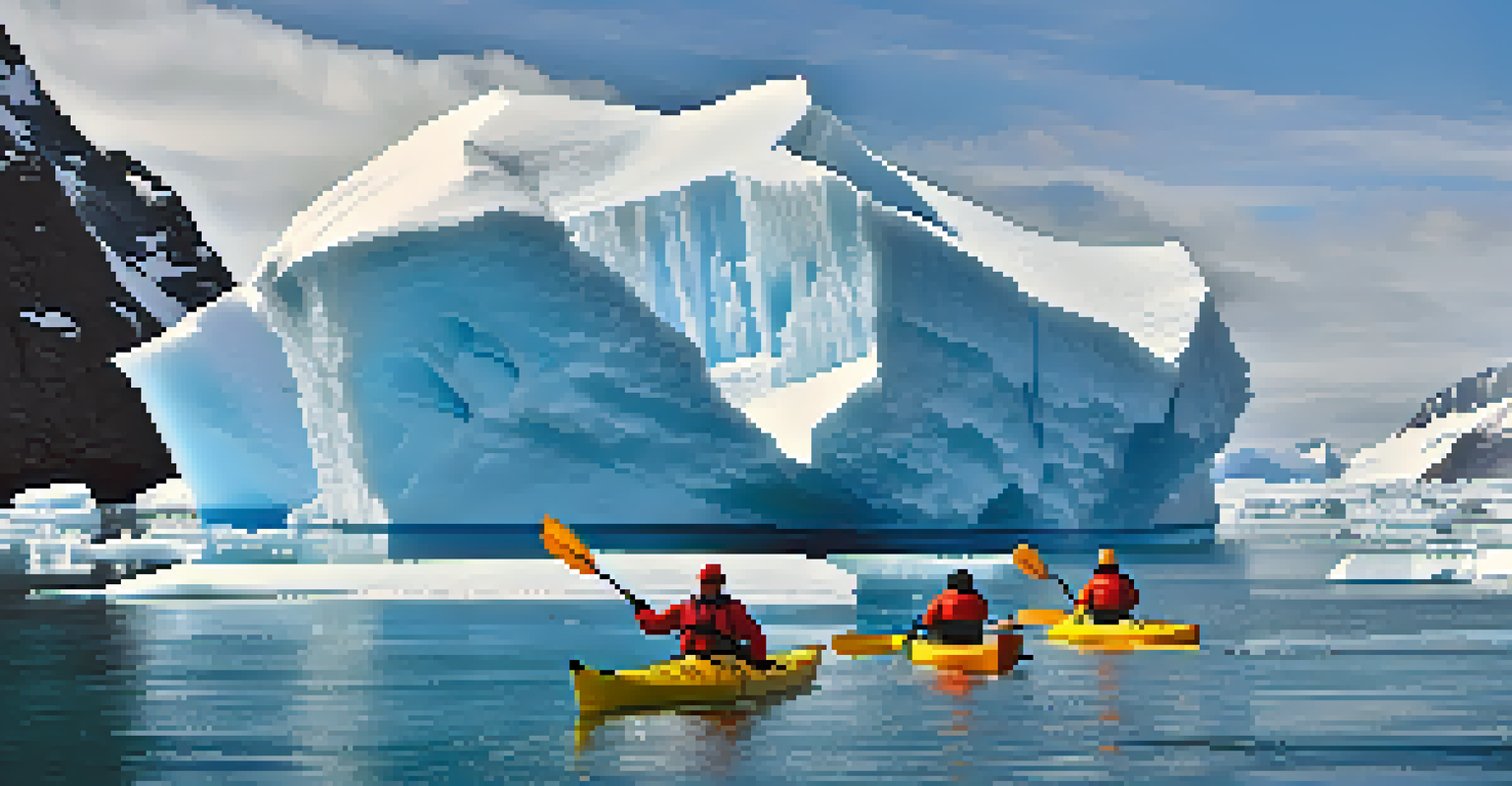Exploring the Wonders of Antarctica: A Travel Guide

An Introduction to the Icy Paradise of Antarctica
Antarctica is often described as the last great wilderness on Earth, a place where nature reigns supreme. With its vast icy landscapes, unique wildlife, and stunning scenery, it's a destination that captivates adventurers and nature lovers alike. Despite its harsh climate, many travelers are drawn to its remote beauty, making it a bucket-list location for those seeking something extraordinary.
Antarctica is an incredibly beautiful place, and one of the last true wilderness areas left on Earth.
The continent is home to the South Pole and is surrounded by the Southern Ocean, presenting a unique ecosystem unlike anywhere else. Here, you can witness majestic glaciers, towering icebergs, and expansive ice sheets that cover the land. This unspoiled environment holds secrets of our planet’s past and continues to amaze scientists and tourists with its raw beauty.
Visiting Antarctica is not just about the destination; it's about the journey. From the moment you board a ship heading south, you begin an adventure that will take you to one of the most remarkable places on Earth. So, pack your warmest clothes and prepare for an unforgettable experience in this icy paradise!
Best Time to Visit Antarctica: Seasons Explained
Antarctica is a land of extremes, and its seasons are no exception. The best time to visit is during the Antarctic summer, which typically runs from late October to early March. During this period, temperatures are milder, and wildlife is abundant, making it ideal for exploration and photography.

In contrast, winter in Antarctica is a harsh affair, with temperatures plummeting and continuous darkness blanketing the land. This time is best suited for research scientists and those seeking solitude, as few travelers venture there. However, if you are keen on witnessing the mesmerizing auroras or the stark beauty of frozen landscapes, winter has its own charm.
Antarctica: A Unique Travel Destination
Antarctica's stunning landscapes and unique wildlife make it a captivating destination for adventurers and nature lovers.
Understanding the seasons in Antarctica is crucial for planning your trip. Whether you want to see penguins waddling along the ice or experience the breathtaking sights of icebergs under the midnight sun, timing your visit will ensure you make the most of this incredible destination.
Getting to Antarctica: Travel Options Available
Traveling to Antarctica is an adventure in itself, as there are a couple of ways to reach this remote continent. The most popular route is via cruises departing from Ushuaia, Argentina, which is the southernmost city in the world. These cruises provide a unique opportunity to journey through the stunning landscapes of the Drake Passage before arriving at the continent.
The greatest threat to our planet is the belief that someone else will save it.
There are also fly-cruise options available, which can save time and provide a more direct route to certain areas of Antarctica. This method is particularly appealing for those who want to minimize time spent at sea, allowing for more exploration once you arrive. Depending on your interests, you can choose the travel style that best suits your adventure.
Regardless of how you choose to travel, the experience will be unforgettable. From the moment you set sail or take flight, you’ll be surrounded by stunning views and the promise of adventure awaits as you approach the icy shores of Antarctica.
Wildlife Encounters: Meet Antarctica's Unique Residents
One of the biggest draws of visiting Antarctica is the chance to encounter its extraordinary wildlife. From the iconic Emperor penguins to the majestic orcas, the continent is teeming with life adapted to its extreme environment. These animals offer a glimpse into a world that few get to experience firsthand.
As you explore the shores and ice, you might spot seals lounging on the ice or whales breaching in the ocean. Birdwatchers will also be thrilled, as various seabirds, including the wandering albatross, soar above. Each encounter is a reminder of the resilience of life in such a harsh landscape.
Best Time to Visit: Timing Matters
Visiting during the Antarctic summer, from late October to early March, offers milder temperatures and abundant wildlife.
Respecting the wildlife is essential during your visit — keeping a safe distance and avoiding disturbances allows these incredible creatures to thrive. Observing them in their natural habitat is not just a privilege; it’s a chance to connect with nature in a profound way.
Activities to Experience: Adventure Awaits in Antarctica
Antarctica offers an impressive array of activities that cater to various interests and adventure levels. Whether you’re looking to kayak alongside icebergs, hike through stunning landscapes, or go for a polar plunge, there’s something for everyone. These activities allow you to immerse yourself in the beauty of the continent while enjoying the thrill of exploration.
For the more adventurous, ice climbing and mountaineering are thrilling options that provide a unique perspective of the icy terrain. Imagine scaling a frozen wall and taking in breathtaking views of the surrounding expanse. Each moment spent engaging in these activities deepens your connection to this magnificent environment.
Additionally, guided tours often include educational programs, allowing you to learn about the continent's history, ecology, and conservation efforts. This blend of adventure and education creates a deeply enriching experience that you'll remember long after your journey ends.
Safety Tips for Traveling in the Harsh Environment
Traveling to Antarctica requires careful planning to ensure safety in its unpredictable environment. Dressing in layers is crucial, as temperatures can fluctuate significantly throughout the day. Waterproof and windproof outer layers will keep you warm and dry, essential for enjoying your adventure to the fullest.
It's also important to stay hydrated and nourished, as the cold can often mask feelings of thirst and hunger. Carrying snacks and water during excursions ensures you maintain your energy levels while exploring. Being aware of your surroundings and understanding the natural environment will help you navigate safely.
Conservation is Key to Preservation
Understanding and supporting conservation efforts is essential for protecting Antarctica's fragile ecosystem and unique wildlife.
Lastly, always follow the guidance of your tour leaders and respect wildlife guidelines. They are trained to keep you safe while minimizing your impact on this fragile ecosystem. With the right precautions, you can enjoy a safe and memorable journey through Antarctica.
Conservation Efforts: Protecting Antarctica's Fragile Ecosystem
Antarctica is not just a travel destination; it’s a vital part of our planet's ecosystem that requires protection. Conservation efforts are critical to preserving its unique wildlife and landscapes. Organizations and researchers work tirelessly to monitor environmental changes, aiming to mitigate human impact on this pristine land.
When you visit Antarctica, you become part of the larger conversation about conservation. Many tour operators emphasize sustainable practices, educating travelers on how to minimize their footprint while exploring. This awareness fosters a sense of responsibility, urging visitors to advocate for the protection of this incredible environment.

Understanding the importance of conservation is essential for anyone who loves travel. By supporting responsible tourism practices, you contribute to the ongoing efforts to keep Antarctica a beautiful and thriving ecosystem for future generations to enjoy.